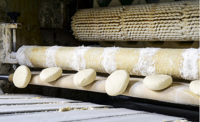Juicing has become quite the trend for today’s health-conscious consumers. However, many at-home juicing techniques still leave the end product a bit clumpy.
That’s why more and more beverage processors are turning to high-pressure processing (HPP) and cold-pressed technologies.
“Cold-pressed and HPP juices are positioned in the marketplace as the highest quality juice,” says Gary Hemphill, managing director of research for Beverage Marketing Corp., New York. “Today’s consumers have shown a willingness to trade up to more premium products if they get value in return. While these products are expensive and are not likely to overtake the market because of that, there appears to be a consumer willing to pay the premium to get the quality these products deliver.”
With the influx of HPP processing comes continued growth in HPP tolling, which gives all cold food processors the ability to produce HPP foods without having to install the equipment necessary to do so.
HPP also provides that extra layer of food safety many consumers desire.
Even more, Millennials are said to be the key drivers in the cold-pressed, HPP market.
According to the 2016 Trend Insight Report put together by FONA International, Geneva, Ill., today’s consumers want healthy, clean labels, customizable flavor offerings and artisan features, all components of what cold-pressed, HPP drinks deliver.
The foodservice sector is even getting in on the act, with savvy restaurateurs offering cold-pressed juices in bottles for when custom blending becomes too demanding of the staff.
As for c-stores, 7-Eleven for example, is partnering with fitness promoter Tony Horton to launch a line of “nutritionally balanced” cold-pressed juices.
The FONA report also provides some areas of opportunity for juice processors:
- Consider expanding juice beyond breakfast to grow the category. Juices provide functional benefits, convenience, artisan qualities and the sweetness factor, all of which appeal to Millennials.
- Millennials love knowing the origin of the ingredients in the products they consume. Barcodes, batch identifiers or any way to show the source of ingredients in a juice appeals to health- and clean label-conscious Millennials.
- Adding a premium juice flavor to sports drink products is an opportunity to further expand the juice category.
Look for growth in the cold-pressed category thanks to companies such as WhiteWave Foods, Suja Juice, Bolthouse Farms, Vital Juice and Evolution Fresh, a division of Starbucks and winner of Refrigerated & Frozen Foods’ 2015 Refrigerated Foods Processor of the Year award.
Ready-to-drink makes its mark
“We’re seeing a broadening array of refrigerated beverage products entering the market well beyond traditional fruit juices and drinks,” adds Hemphill.
Refrigerated tea, for example, is growing, and refrigerated coffee is beginning to make its mark, to name a few. The market has also seen packaging innovations such as plastic carafes designed to give products a more premium image.
“We’re seeing more premium plastic packages entering the refrigerated section of stores—carafes and other unique packaging designs—that give brands a distinct look and allow them to stand out better on the refrigerated shelves.”
Other trends impacting the beverage industry
Here’s a rundown of other trends impacting the refrigerated and frozen beverage market.
- Antioxidants, prebiotics, probiotics, electrolytes and even fiber are key attributes.
- Vegetable-blended and fruit-blended flavors have seen growth, especially in the fruit juice occasions.
- Juice smoothies have emerged as a go-to choice.
- Lightweighting, sustainability, quality and cost are among the many factors beverage brands should consider before choosing a packaging material.
- Demand for pouches in the United States will grow 4.4% a year through 2020 to $10.1 billion, according to the Freedonia Group, Cleveland, Ohio.
Click here to view market trends reports for this category.
To learn more about these and other new retail products, go here.




